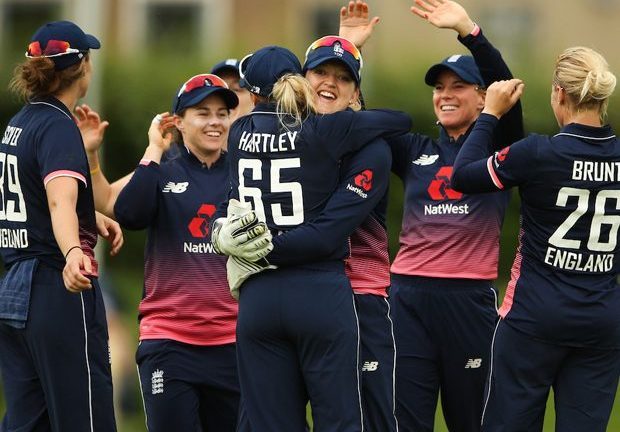The Vitality Tri-Nation series was completed with a single T20 match between England and New Zealand at Chelmsford on Sunday 1 July.
If the result looked like a foregone conclusion – the home team romping home by 7 wickets to record their 13th win against this opposition – all three nations can draw valuable lessons for future profit.
Early on, it looked as though the White Ferns would carry the day. Their two most experienced and able bats, skipper Suzie Bates and Sophie Devine, set off at a worrying pace. Home spectators hunted for their lucky charms as 54 runs were devoured in five overs.
Then Katharine Brunt achieved what she has so many times before – two wickets in quick succession. When Sophie Ecclestone got Bates to play an unwise shot to a straight ball, the charms had worked like a charm. The visitors’ abiding weakness, lack of depth in both batting and bowling, meant that England’s bowlers could wrest back the initiative with a clear-headed approach, based on the time-honoured principle ‘You miss, I hit’. After the departure of the two openers, both for 31, only two more double-figure scores were registered, and a total of 129 looked less than threatening.
After the break, Tammy Beaumont and Danni Wyatt clattered the ball to all parts, showing little fear of an early mistake. Wyatt in particular showed courage after a failure or two, and took the plaudits with a magnificent 50 off 35 balls. When both were dismissed, England showed why they deserved to complete this series as top dogs. The middle order is now full of confidence. Even when young Amelia Kerr won the most-prized wicket of Sarah Taylor with a joyous googly, Heather Knight and Nat Sciver waltzed through to the target at a strike rate of 150.
Score:
New Zealand 129
England 130-3
Review
All three nations, England, New Zealand and South Africa, will have entered this series of matches with their eyes on two separate targets: a win in the here and now; and a set of performances to enhance more important future campaigns like World Cups. Only one team could be a winner here in the high summer of 2018, but the losses and comparative weaknesses could be worked on relentlessly over the coming months.
South Africa were the babes of the trio, with a less impressive past record than their rivals, but they knew they were building a highly competent squad, encouraged by the nerve-tingling loss to England in last year’s World Cup semi-final. They performed exceptionally well in two games, both against England, trouncing them against all the odds in the first ODI at Worcester, then repeating the dose at Taunton in the first of the T20s. Given the history of South African sport over the last half century, it was excellent to see all the constituent members of the present population contributing powerfully to the common cause. They had an experienced leader in Dane van Niekerk. Their quick bowlers, though inconsistent, had the pace and skill to run through England’s top batting twice. Their fielding was mostly alert and aggressive. Lizelle Lee showed the problems they face currently. An outstanding, hard-hitting bat, she also had to keep wicket, and that didn’t help the nation’s cause.
New Zealand have different problems, which take us back to one incontrovertible fact: the smallness of the population. They have no trouble in filling any number of powerful rugby squads, but cricket is another matter. They are well organized and supported back home, but can never be certain of creating an entire team capable of seeing off the world’s toughest opposition.
They weren’t at full strength on this tour; no Rachel Priest for example, and last year’s top world one-day player, Amy Satterthwaite, couldn’t repeat her golden run of four centuries on the trot. This reduced the White Ferns’ batting strength more than they wanted. Once Bates and Devine were accounted for, their opponents didn’t have to work hard enough to snare the remaining wickets. They may ponder splitting the pair up to provide greater balance to the batting order.
There was some promising spin bowling on view from both visiting sides, including a healthy quantity of wrist-spin. Its rarity value on English pitches always adds to the chance of a false shot, as when Amelia Kerr deceived England’s greatest bat. On the other hand, Dane van Niekerk was one leg-spinner who needed more variations to create doubt in the batter’s mind.
South Africa’s frontline bowlers must wonder what went wrong. A comparison of their figures against England in the ODI at Worcester and against the White Ferns in the T20 at Bristol makes for sober reading. In the former they snared nine English wickets at an average of 3.55 runs per over. In the latter they waited till halfway through the 17th over to gain their first wicket, at a cost of 182 runs. Ironically they made excellent use of typically English conditions at New Road. When the ball stopped misbehaving – as it did for most of the rest of their tour – they found life difficult.
So did the New Zealanders. The coaching staff will be anxious to find strong back-up for Sophie Devine’s opening spells. She is the nearest thing they possess to a real-life Brunt in style and attitude. The 20-year-old Jessica Watkin was promoted to the XI after encouraging performances in Ireland. The two outstanding wickets she took with her off-spin to dismiss Beaumont and Wyatt will give her confidence in future contests. The 17-year-old Amelia Kerr is obviously a star in the making. She arrived from Ireland with a fairy-tale story to tell: 232* runs in a total of 440-3 against the hosts, and five wickets thrown in as an afterthought are the stuff our own cricketing dreams are made of. For her it was reality. In the more demanding arena of matches against South Africa and the world champions, she couldn’t maintain that sort of millionaire’s progress, but it was evident that New Zealand have strong material to work on.
The South African management will be looking for much more consistency. The Proteas’ experiences over the past few weeks will be fodder for them to chew on. How to be consistent with the ball, how to keep the scoreboard ticking over without throwing wickets away? Again, it’s largely a matter of learning from experience. As Watkin said of her ‘surprise’ inclusion in the Ferns’ team, she couldn’t help learning, not only from the old heads around her (Satterthwaite, Devine and Bates), but watching the English players at work.
Mark Robinson expressed his satisfaction with the outcome of events. He will be aware of areas that still need careful attention: the bowling and the out-cricket came under stress more often than is healthy. But his squad – which keeps on changing – is showing the depth that is so vital in international competition.
Of the four players, Beaumont, Winfield, Wyatt and Jones, who have opened the batting in recent months, only Beaumont has returned consistent figures (256 runs in the T20s). The middle order produced the goods more often than not. It was heartening to see the skipper approach her batting with confidence and aggression.
The bowling proved itself when it mattered in the Chelmsford final, but it is far from the finished article. No younger bowler put down an indelible marker as a support for the overworked Brunt and Shrubsole. Katie George was given an opening late in proceedings and looked the part at Bristol. Her left-arm approach is a bonus against batters who aren’t sure where their off-stump is. Other quicker bowlers like Tash Farrant (another laft-armer) and Kate Cross must wait their turn – again.
Despite the gold-plated arrival of Sophie Ecclestone on the world stage – she walked off with a thoroughly deserved Player of the Tournament at Chelmsford – Robinson still can’t be certain of his best spin options. He brought Danni Hazell in for the T20 series in exchange for Laura Marsh. She has the character to disregard little local difficulties and took some useful wickets, but a combination of her and Marsh might be the ideal compromise. Unfortunately, selection isn’t allowed such wishful thinking. England are lucky that the skipper can slip herself on to bowl a few tidy overs if the opposition threatens to barnstorm.
When Ecclestone was preferred to Alex Hartley, her Lancastrian team-mate, you feared for the latter’s future. But Robinson has deftly removed that worry by recalling Hartley for the coming ODI series against New Zealand. It’s good news for her, but it means the management are still looking around for the ideal combination of bowlers. Form comes and goes, but it would be nice to think that England’s elite don’t have worrying dips that threaten immediate removal from the ranks.
The wicket-keeping on show was a different matter. Both Katey Martin (NZ) and Lizelle Lee (SA) brought off admirable stumpings, but there the comparisons with England’s star-turn end. Sarah Taylor needs no further glorification; she stands in a class of her own.
The selectors want to keep all the prospective players under review. The KIA Super League coming up in August will give them the chance to assess form against the world’s best, but only in the T20 format.
India and Australia will have been looking on from behind shaded windows to see what new threats, if any, were coming their way in future world competitions. The three nations competing here in June and July know that the big bears are prowling elsewhere, ready to gobble them up if their defences are weak. On present evidence, only England have a chance of upsetting Australia, and they know how tough a challenge that can be.









